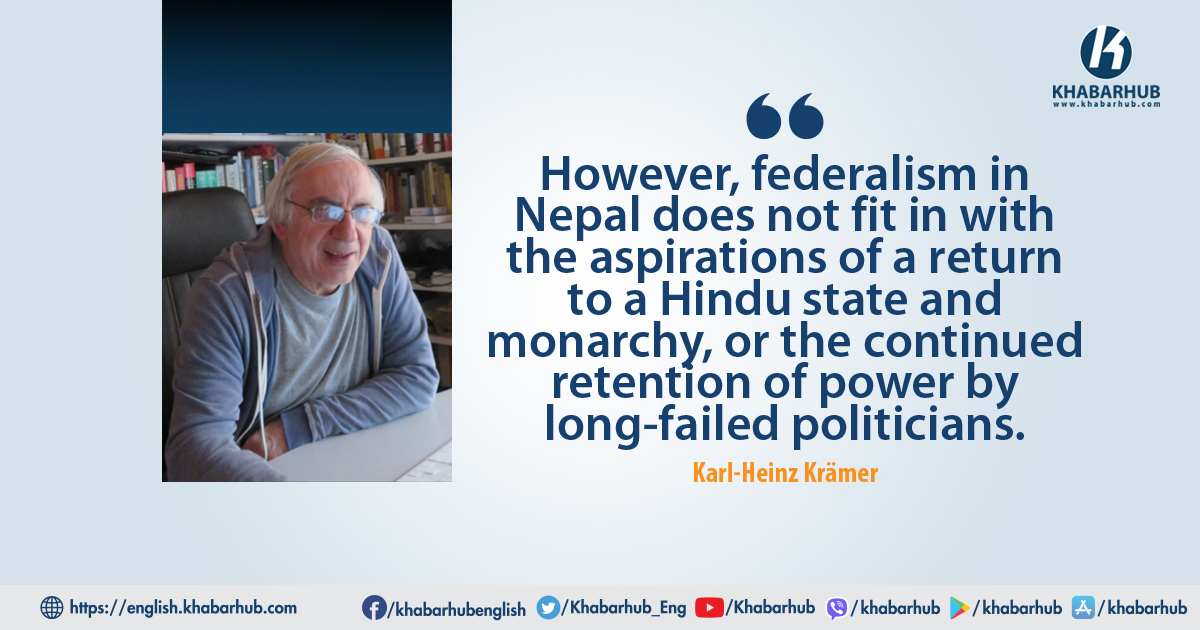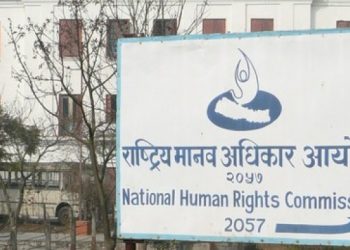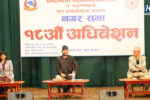With the 2015 constitution, Nepal declared itself a federal and secular republic. This was done in light of the fact that all parties, including the conservative RPP, had committed to better social and regional inclusion after the end of the royal coup in 2006.
Historical developments
Although the 1990 constitution had already recognised that many social groups of different languages, cultures and religions lived together in Nepal, this had not brought about any change in the social groups involved in central political power.
The patriarchy of the so-called high Hindu castes remained in place and became even more blatant.
Only the weighting within this group of males from the Bahun and Chhetri castes, which only made up around 15 per cent of the Nepalese population, had changed significantly in favour of the Bahun castes with democratisation and the re-admission of political parties.
The bottom line, however, was that Nepal remained an extremely centralised state. Even during the panchayat period, neither the 75 districts and 14 zones nor the ultimately five development regions had been able to change this. Almost all development efforts remained concentrated in the centre of the country.
The far west, i.e. the Mid-Western and Far-Western Development Regions, remained particularly neglected.
The idea of federalism in the Constituent Assembly
If Nepal was serious about eliminating these development failures, it was necessary to transfer greater power and decision-making authority to the remote regions of the country.
From both a regional and societal perspective, this approach was in line with the idea of inclusion promised in 2006.
The demand for a system of federal provinces had already been developed by the Janajati groups in the mid-1990s.
The main idea behind this was to create areas in which the various Janajati groups represented a relatively large social group.
The Maoist party, on the other hand, was strongly in favour of a provincial structure in which traditional ethnic and linguistic areas were placed in the foreground.
It was hoped that this would enable them to better preserve and cultivate their own culture, language and religion and thus give them greater weight in the Hindu state of the ruling male central elite, which in principle continued to exist.
This idea of the Janajati groups was soon adopted as one of the core ideas of the insurgent Maoist party.
This proved to be a skilful move because it attracted a particularly large number of people from the Janajati circle to the Maoist party.
It was no coincidence that the original centre of the Maoist movement was located in a particularly neglected region with a high proportion of Janajati.
When the idea of federalism was seriously debated during the drafting of the new constitution by the elected first Constituent Assembly from around the beginning of 2010, it quickly became clear that this issue would become the key problem in the drafting of the new constitution.
Completely different basic attitudes clashed. On the one hand, there were political representatives who did not want to change much from the previous system of five development regions.
The future provinces were therefore to include similar proportions of high mountains, Pahad and Tarai. This should also help to avoid potential ethnic or ethnic-linguistic majorities in a province as far as possible.
Not even the names of the provinces were to be reminiscent of historical or ethnic areas in any way. This view was advocated in particular by the Nepali Congress and CPN (UML) parties, which together had fewer representatives in the first Constituent Assembly than the CPN (Maoist).
With the elections to the second Constituent Assembly, the majority situation changed radically. The CPN (Maoist) plummeted, while the Nepali Congress and CPN (UML) together had almost a two-thirds majority.
The two dominant parties of the 1990s system claimed that there was a danger of separatism if ethnic and linguistic criteria were to take centre stage in the federal division.
However, the decisive factor was probably that the ruling elite of these two parties feared that their power and privileges would be jeopardised.
The Maoist party, on the other hand, was strongly in favour of a provincial structure in which traditional ethnic and linguistic areas were placed in the foreground.
This roughly corresponded to the attitude that the party had already developed during its militant uprising. At the turn of 2009/10, the Constituent Assembly committee responsible for the federal structure submitted a proposal that envisaged 14 provinces divided according to ethnic, linguistic and regional criteria.
As a two-thirds majority was required to pass the constitution, there was no agreement in sight. In 2011/12, Baburam Bhattarai tried once again in vain to bring about a compromise by means of a State Restructuring Commission (SRC) during his short term as Prime Minister.
Ultimately, however, the constitution-making process failed in 2012 due to disagreement over the federal system.
There was a special problem regarding the federal division of the Tarai. For a long time, the Madheshi representatives had demanded a single Tarai province that was contiguous from east to west.
The principle of ethnic, linguistic and historical non-reference was retained in the naming process. However, the central leaders of the dominant parties in the Constituent Assembly had long since understood how to control the political level of the provinces.
In the end, two separate Tarai provinces were agreed upon, but even this went too far for the leaders of the Nepali Congress and CPN (UML). In the Tarai in particular, they played on their fears of separatism.
With the elections to the second Constituent Assembly, the majority situation changed radically. The CPN (Maoist) plummeted, while the Nepali Congress and CPN (UML) together had almost a two-thirds majority.
The latter two parties were thus able to push through their idea of a federal system as far as possible, especially as the Maoists tried to save what could still be saved and largely dropped their idea of an ethnically and linguistically based federal division.
The previously agreed promises to the Tarai groups were also rejected by the major parties. Today, six of the seven provinces have at least some share of the Tarai. Only Province 2, now Madhesh, is still a pure Tarai province.
It was not least this approach that caused the storm of indignation that broke out along the Indian border in the south immediately after the constitution was adopted in 2015 and led to a blockade of the border points, which was at least tolerated and encouraged by the Indian side.
Federalism in constitution and practice
Now Nepal no longer has five cross-regional development regions without any historical, ethnic or linguistic background, but seven, which are now called provinces. In terms of content, little else was regulated regarding the federal system when the constitution was adopted.
It was not even possible to agree on the names of the provinces. They were simply numbered from 1 to 7.
The official names were then to be decided by the first provincial assemblies to be elected, i.e. from the beginning of 2018, within six months, as stated in the constitution.
If the federal provinces are to serve to decentralise political power and better safeguard regional interests and tasks, then their political institutions must also have a certain degree of autonomy within the framework of national unity.
However, it took five years for all the names to be finalised and at least the name of Koshi Province is still controversial.
The principle of ethnic, linguistic and historical non-reference was retained in the naming process. However, the central leaders of the dominant parties in the Constituent Assembly had long since understood how to control the political level of the provinces.
This total control of the provinces by the central political level is evidence of a blatant misunderstanding of federalism.
The way the federal system presents itself in Nepal’s political practice today, the provincial level merely serves to expand the power of the top national politicians of the parties.
Although the bloated system of the Constituent Assembly with a theoretical 601 members has been reduced to 275 members of the House of Representatives plus 59 members of the National Assembly, seven provincial assemblies with a total of 550 members have been created at the same time, whose selection and behaviour are largely determined by the national party leaders.
Today, the latter not only select the members of the two national chambers of parliament in elections, but also the members of the seven provincial assemblies as well as the provincial governments.
One gets the impression that the provinces primarily serve to provide potential posts for the clientele of the national political leaders and parties.
The fact that such electoral alliances are ultimately the exact opposite of free and fair democratic elections is of no interest to these politicians, nor is the selection of the respective alliance partners; the main thing is that enough MPs can be secured through this manipulation to maintain power.
If the federal provinces are to serve to decentralise political power and better safeguard regional interests and tasks, then their political institutions must also have a certain degree of autonomy within the framework of national unity.
The fiscal sources necessary for the provinces must be just as clearly defined and separated from the national budget as their responsibilities. Overlaps should be minimised and, if necessary, clearly regulated.
Eight and a half years after the constitution was adopted, national politicians across the board have failed to even consider such a division of responsibilities and delimitation.
Worse still, they make it clear with all their actions and statements that they are not even thinking of decentralising power and responsibilities. Within themselves, they continue to think in extremely centralised terms.
This becomes particularly blatant when a government breaks down at national level and a new one is formed. This traditionally happens at least once a year in Nepal.
Although the national political leaders then generally claim that the new government will remain in office until the end of the legislative period, they almost simultaneously start new power struggles, which at some point lead to the collapse of the new government as well.
If there is a change at national level, it does not have to be replicated in all the provinces. This is the only way to guarantee political stability in the long term.
One of the main reasons for this inconsistency is that the top politicians are only interested in maintaining their power, but not in democracy, i.e. the rule of the people and their welfare.
These power games are backed up by a variety of manipulations. They begin even before elections in the form of so-called electoral alliances.
These have the sole aim of securing as many seats as possible for their parties in the parliament to be elected.
The fact that such electoral alliances are ultimately the exact opposite of free and fair democratic elections is of no interest to these politicians, nor is the selection of the respective alliance partners; the main thing is that enough MPs can be secured through this manipulation to maintain power.
If this does not succeed despite such an alliance or if no internal agreement can be reached on the distribution of power, the entire alliance is declared null and void after the elections if necessary and a coalition government is formed with completely different partners.
It doesn’t matter that the already manipulated votes of the electorate are once again misused. That’s just the way democracy works in Nepal according to the understanding of the top politicians.
But all this is by no means enough. If such a change of government takes place at national level, then such a change must also be implemented immediately in all provinces.
However, federalism in Nepal does not fit in with the aspirations of a return to a Hindu state and monarchy, or the continued retention of power by long-failed politicians.
This is also proof that national politicians have absolutely no understanding of federalism. In a federal state, it is characteristic that parties A, B and C form a government at national level and parties B, C and D form a government in one of the federal provinces, for example.
If there is a change at national level, it does not have to be replicated in all the provinces. This is the only way to guarantee political stability in the long term.
In Nepal, however, the national party leaders interfere in all the affairs of their parties at provincial level, prescribe the coalition partners and determine who the chief minister should be.
Everything has to fit into the pattern of irrational coalitions at national level and be agreed with the partners there. If necessary, this also exacerbates the factionalism that can be found in many parties.
Federalism in Nepal does not follow the will of the voters, but that of politicians who are exclusively interested in power.
In fact, the federal system in this form makes no sense at all. With this statement, however, I expressly do not want to agree with the fundamental criticism of Nepalese federalism that is often levelled by the monarchist RPP, but also by the still young RSP.
Federalism can be an important contribution to decentralisation, social inclusion and national unity if it is handled correctly and respected. It does not contribute to separatism, as various conservative forces, including those from the major parties, claim.
However, federalism in Nepal does not fit in with the aspirations of a return to a Hindu state and monarchy, or the continued retention of power by long-failed politicians.
(The views expressed in this article are those of the author and do not necessarily reflect the official policy or position of Khabarhub)









Comment